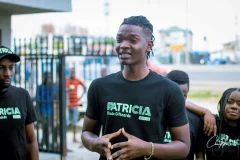Do you need a guide for all the big tech terms people are throwing about on the internet? What do blockchain, NFT, DAO and crypto mean?
Over the past couple of years, there’s been an influx of words that explain certain tech concepts. Some of them like crypto, or even NFTs, have been around for a while. In fact, NFT—as a word—was first used in 2014 and now, 7 years later, it’s still a concept that escapes a lot of us. Others like DeFi or DAOs are fairly new, but they’re still getting thrown around a lot.
Whether you’re new or old to tech, reading about concepts can feel like learning a new language. So TechCabal is creating a guide—short explainers—for common tech terms. In this, you’re sure to find simple short explanations that can help you understand NiFTy concepts.
1. Blockchain
A few of the concepts we’ll explain here are based on blockchain so it’s important this goes first.
Blockchain is a record-keeping tech that’s designed to make it impossible to hack the system or forge the data stored on it.
How it works: Standard databases store data in rows, columns and files, but blockchain stores data in blocks that are chained together. The data on the blocks are continuously updated, encrypted, and stored on several computers so there’s no single computer to hack or control the data from.
In explaining blockchain, Buchi Okoro—CEO and co-founder of African cryptocurrency exchange Quidax—said: “Imagine a book where you write down everything you spend money on each day. Each page is similar to a block, and the entire book, a group of pages, is a blockchain. With a blockchain, everyone who uses a cryptocurrency has their own copy of this book to create a unified transaction record. The software logs each new transaction as it happens, and every copy of the blockchain is updated simultaneously with the new information, keeping all records identical and accurate.”
2. Cryptocurrency
We all know what currencies are—dollars, pounds, shillings. Well, cryptocurrencies are digital currencies. You can’t hold it the way you’d hold fiat currencies like CFA coins or naira notes, but you can still spend it on things you love.
How it works: Cryptos are digital currencies created on blockchain technology. If you got a sense of what blockchains are, then you’ll understand what we mean when we say that cryptocurrencies are decentralised; no one person or government controls them. They are created by algorithms and used to award engineers—called miners—who carry out maintenance on the blockchain.
Unlike fiat currencies which derive their value and validity from states, cryptocurrencies derive their value and validity from the blockchain.
3. Non-fungible token (NFT)
Don’t be fooled by its mushroom-sounding title, NFTs are in fact inedible, even the NFT flavours. NFTs are unique digital assets created on a blockchain.
How it works:
Think of it this way, when you go to a museum and take photos of artefacts, what you have is just a photo which isn’t quite valuable. The museum still has the original valuable artefact.
It’s similar with NFTs. We can take screenshots of Niyi Okeowo’s $2,800 Indigo Child (below) but it doesn’t mean we own the asset. The original copy—the property rights and certificate of authenticity—belong to the buyer.

4. Web3
You’ve probably seen tech bros throw the word “Web3” around a lot. It’s the answer experts give to questions from “What is the future of the internet?” to “What does Spiderman navigate the internet with?”
But what exactly is Web3? To put it simply, Web3 is taking democracy to the internet.
Let’s take a look at Web3’s ancestors, Web1 and Web2, so we can understand what it’s all about.
- Web1 was the earliest version of the internet, which existed between the 1900s and the early 2000s. In this version, content was delivered via texts and graphics to users who could only consume the content but not interact with it.
- Web2 is what we have now, an interactive and social web where companies can build revolutionary apps that allow users to become creators. It’s centralised, i.e. controlled by companies or governments who can decide when websites, apps or content can be taken down with little input from users.
- On Web2, apps are only available for as long as the company that owns them decides. Streaming sites can shut down, online games can upload patches users don’t like (yes, I’m looking at you Riot Games), and traditional banks can freeze bank accounts when the government demands it.
How Web3 works: Web3 will be built on the blockchain working independently from different parts of the world.
On Web3, decisions regarding the design and operation of products and funds—including crypto—will be made by communities of people called Decentralised Autonomous Organisations (DAOs), and not governments or companies. So if you find an app or product you like, you can join the DAO of that product, buy shares and vote on which changes should be made.
For example, if you joined TechCabal’s DAO, you’ll get to decide how we upgrade or downgrade depending on how much shares you have in the DAO.
5. Decentralised Autonomous Organisations (DAOs)
DAOs or Decentralised Autonomous Organisations are social communities that will create rules and regulations which will be embedded in programming codes.
How it works: Unlike conventional organisations like TechCabal, which have managers and boards of directors that govern it, DAOs are governed by communities—who don’t have to be developers of the product. DAOs are created by developers who decide on a set of rules and embed it in—digital contracts on blockchain that are executed when certain conditions are met.
The communities decide what happens to the products attached to that DAO, what upgrades to make and when to make it. Each DAO will have its own token which will be sold to its community members, and the more tokens you have, the heavier your stake and voting rights.






















